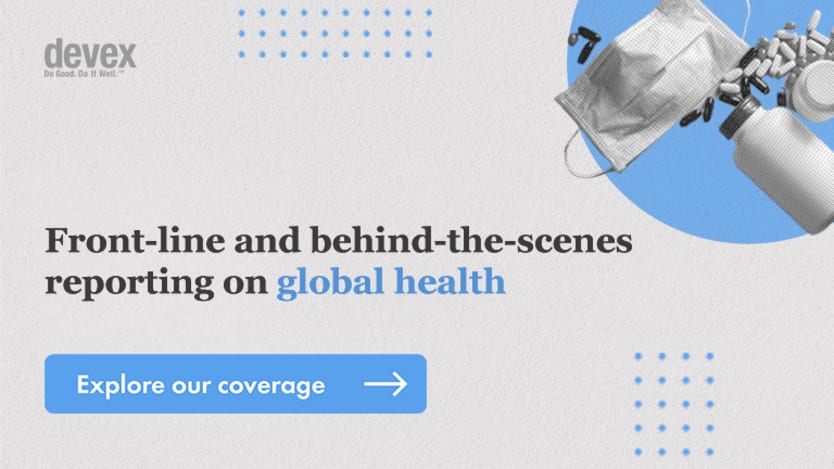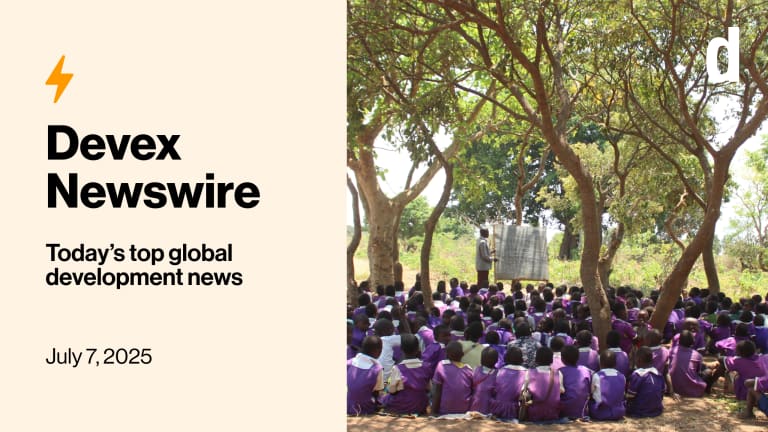
Sign up for Devex CheckUp
The must-read weekly newsletter for exclusive global health news and insider insights.
The official death toll from COVID-19 is set to reach 5 million within a week, according to data from Johns Hopkins University. It has been six months since 4 million deaths were recorded on July 7 and despite a slowing of growth, the virus continues to take advantage of gaps in the global response.
Geography of deaths
Leading total deaths is the United States with more than 737,000 deaths as of Oct. 25. It is followed by Brazil with 605,804; India with 455,068; Mexico with 286,496; and Russia with 227,506. A total of 13 countries now have six-figure death tolls.

The U.S. is not just a leader in overall deaths, but also new deaths. Since July 7, more than 131,000 new deaths were added to the total, accounting for 17.8% of all deaths.
Russia has added almost 90,000 new deaths to their total since July 7, accounting for more than one third of their total deaths. This growth has resulted in new lockdown restrictions to fight the growing outbreak.
Indonesia added more than 80,000 deaths, accounting for 56% of their total deaths; while Brazil added more than 77,000 — or 13% of total deaths — and Mexico and India each saw an excess of 50,000 deaths.

According to the World Health Organization, the Western Pacific has seen the fastest rise in deaths. Over 70,000 new deaths have been recorded since July 7, more than doubling the regional total. Massive growth has been recorded in Malaysia — over 22,000 new deaths — and Vietnam — over 21,000 new deaths. On July 7, Vietnam had recorded just 102 deaths.
Despite this growth, the Western Pacific is home to the lowest total deaths: 126,000. The African region, which excludes Egypt, has recorded less than 150,000 deaths in total. But deaths have been rising rapidly since July, particularly in South Africa which has added almost 26,000 deaths. A total of 13 countries in the region have seen deaths double since July, including Zimbabwe which has added 2,700 deaths, and Namibia which has added over 1,800.
COVID-19 deaths versus vaccinations
The increasing number of deaths in the African region is combined with the slow vaccine rollout, creating concern for more deaths to come. Just 10 countries have been able to fully vaccinate more than 10% of their total population. Seychelles is leading the way – more than three quarters of their total population are fully vaccinated – followed by Mauritius at 66%, Eswatini at 20%, South Africa at 20%, and Zimbabwe at 17%. Four countries have yet to fully vaccinate 1% of their population: Cameroon, Ethiopia, South Sudan, and Uganda.

“We’re by no means near the finishing line for this pandemic,” Dr. Matshidiso Moeti, WHO regional director for Africa, said in a media briefing on Oct. 14. “For the end to be in sight, vaccination rates must dramatically increase, case management capacities should be expanded, and basic public health measures – including active case findings and testing – should be reinforced.”
The eastern Mediterranean and Southeast Asia also have yet to see more than a quarter of their total population fully vaccinated. The lack of information on fully vaccinated populations in North Korea, Djibouti, Libya, Somalia, and Yemen is partially responsible for these tallies.
Elsewhere, vaccinations are dramatically uneven.
The Western Pacific has the largest population of fully vaccinated individuals, thanks to strong rollouts in Cambodia, China, Japan, Malaysia, and Singapore. Over 70% of the total populations are fully vaccinated. But in Papua New Guinea, just over 1% of the total population is fully vaccinated as the government looks to mass burials to ease the growing burden on morgues.
Underreporting remains a concern
But 5 million deaths are just the tip of the iceberg. Underreporting has been an issue since the beginning of the pandemic, especially in countries struggling with mortality registration prior to the COVID-19 pandemic, and countries facing additional crises and conflict.
Comparisons of excess mortality statistics, an analysis of burial patterns, and citizen science approaches have seen modelling estimate that the death toll is missing 50% to 75% of deaths. WHO will soon be releasing new data which they hope will augment this critical knowledge gap.









